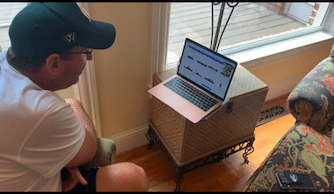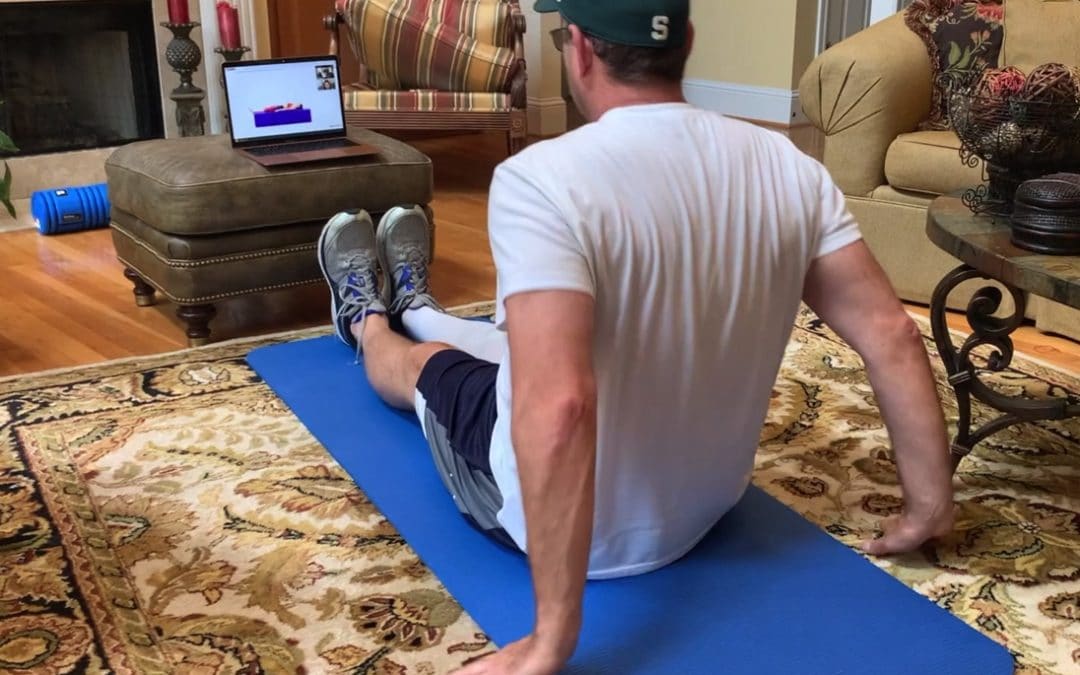Total Knee Replacement Recovery at Home – A Caregiver’s Perspective
by Nick Ovington
A History of Chronic Pain and Knee Complications
Chronic pain has hindered my father, Tim, throughout his life. During his youth as an avid athlete and outdoorsman, he suffered multiple knee injuries. Over time, constant strain and damage eroded the cartilage in his knee, causing severe osteoarthritis. Osteoarthritis is a progressive disorder which causes stiffness and swelling in the joints because the cartilage that prevents bones from rubbing against one another wears down. As a result, Tim experienced intense pain while performing daily activities. The stiffness rendered him virtually unable to enjoy his passions such as hiking and tennis. Although he was stoic and never complained, he became conditioned to being in discomfort.
Tim tried every available solution that could potentially grant him relief. Over 3 decades, he underwent multiple procedures and surgeries including bilateral ACL reconstruction, arthroscopies, and steroid and stem cell injections. Unfortunately, these procedures granted him only short-term, minor relief. After the efforts failed to produce significant long term improvements, specialists advised my father that a total knee replacement was necessary.
The Surgery
The total knee replacement surgery was originally scheduled for early April 2020. The date was ideal because my mom had taken two weeks off from work, and I was home for the summer; we would be available to care for him. Although we understood that the recovery would be tough, we were confident that it would finally provide him with long-term relief. The plan was sound – following surgery, he was to spend as much time as needed recovering in the inpatient rehabilitation center. Once well enough to return home, Tim would meet with a physical therapist three times a week until he regained full mobility (we understood the importance of proper post-op care following a surgery of this caliber). We were confident that the procedure would finally provide Tim with the relief he deserved!
However, the onset of the COVID-19 pandemic changed everything.
As a result of the virus, mandated regulations forced hospitals and surgical centers to cancel elective medical procedures. My dad’s surgery fell into that category and was postponed. After much anticipation, the order was lifted and his total knee replacement surgery was rescheduled for May 11th.

It became apparent that Tim’s surgery and subsequent recovery would be radically different than what we had planned. We were informed that regulations were put in place which did not permit my mom and me to be present in the hospital for the operation. We were also informed that he would get discharged immediately following surgery. Additionally, the in-person physical therapist treatment plan would not be occurring because it would be unsafe to meet with a clinician face to face.
The surgeon called us three hours after dropping him off at the hospital; the surgery was a success! The three of us were relieved that there were no complications, but we also shared sentiments of anxiety and stress. Routine physical therapy following a total knee replacement is essential and expecting him to get better without it seemed like a gamble. Weeks after the surgery, Tim continuously experienced throbbing pain and stiffness while attempting to walk with crutches and was unable to bend his knee 90 degrees. After failing to recover on his own, we then understood that the recovery depended on discovering a viable way to complete physical therapy from home.

The Moterum VRC Platform
Like many of us, my father had never met virtually with a clinician before. The concept of being treated through a screen at home was unusual to him. Though he understood the effectiveness of telehealth in theory, he was going to experience it firsthand. After an explanation from his clinician, he became excited and was committed to recovering using the Moterum Virtual Rehabilitation Clinic platform.
The set up was simple; his physical therapist, Brie Darcy, DPT. sent him an invitation to join via email, giving him the option to access the portal from his phone, tablet, or computer. Once in the system, he created a profile and explored the portal. He was relieved to learn that the platform was extremely user friendly and simple to understand. The home page showed his schedule, which included his initial consultation, treatment sessions, and tasks. He opened the scheduled consultation and was instantly connected to his physical therapist via video chat. She asked him questions regarding his condition, pain levels, etc. and gave him an overview of what to expect during treatments. His clinician was able to provide a thorough assessment of his current condition and feasible progress. Even though not in the same room, Tim and his physical therapist interacted just as they would in a clinic setting. Afterward, we navigated to his schedule and previewed an upcoming customized treatment plan that was added by his clinician. The treatment plan showed various exercises, complete with the title, amount of sets/reps, and a video preview.

Treatment
After getting familiar with the platform and understanding what to expect, my dad woke the next morning excited to complete his first treatment session! He propped his laptop on the couch, which allowed him to view the treatment video and speak to his clinician at the same time. Throughout the session, his physical therapist engaged with him. Her input ranged from correcting his form, offering words of encouragement, and explaining the specific purpose and benefits of each exercise. I was amazed that the physical therapist was able to assist him as if they were together in person. He performed nine different exercises over 30 minutes that helped his range of motion, strength, and flexibility (including knee extensions, straight leg raises, side knee planks, and knee flexion). He completed the first treatment session and could not wait for the next!
The very next day, Tim was able to finally bend his knee to 90 degrees. He also began walking short distances without his crutches. All the frustration he felt during the past few weeks of trying to recover on his own dissolved and was replaced with hope and confidence. After a single treatment session, it was evident that remote PT was helping him dramatically.
Later that day, Tim’s PT directed him to explore the “usage and outcomes” section of the portal. The usage section allowed us to view his treatment results and track progression over time. He also completed a few outcome assessments, which gave his clinician more insight into how he was doing and feeling. This data was automatically uploaded and formatted within the portal, represented in graphical and table format. I was thankful for this feature, as it allowed me to keep track of my dad’s progress. Additionally, this data was used by his clinician to adjust each subsequent treatment session, which continuously optimized his treatment plan.

The Results
After three weeks of daily treatment sessions, my dad made tremendous progress in his recovery. He became able to walk long distances without any assistive walking device and was liberated from the debilitating pain and stiffness he had become used to his entire life. The next month, we put his improved mobility to the test. My family took a trip to the Grand Teton national park, where we hiked and fished every day for a week. He was able to trek long distances over uneven terrain (and even outpaced me most of the time)! His leg was exponentially better, and he was finally fully mobile.
Remote physical therapy proved to be the perfect solution for my dad. The Moterum platform provided him and his clinician with a medium to facilitate productive therapy sessions from a distance. With the inclusion of helpful tools such as remote patient monitoring, interactivity, live treatment sessions, and usage/outcomes tracking, the portal served as an advanced yet seamless treatment tool. With his clinician providing consistent feedback by monitoring and tracking his progress, it truly felt like the portal was a clinical extension into the home. My dad’s compliance was even higher due to the consistent engagement and motivation via the platform. Virtual rehabilitation was easy to use and effective, and I am grateful to see my dad more independent, active, and without chronic pain. Tim even claims that he is now walking the best he’s walked in years!
Remote physical therapy helped my dad and it can work for you too!
